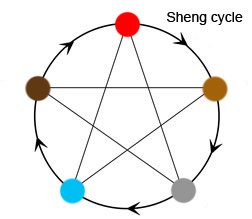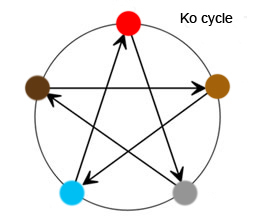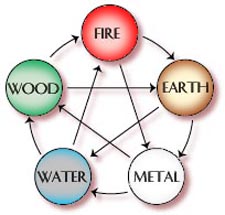Table of Contents
What is the Five Element Theory?
According to the Five Element Theory, the qualities of Wood, Fire, Earth, Metal, and Water can be used to describe the basic elements of the material world. These elements are in constant flux. Additionally, the complex inter-connections and interactions within the material world are explained through the relationship of interdependence and mutual restraint that governs the Five Elements. In Traditional Chinese Medicine, the Five Element Theory is used to interpret all relationships between the physiology and pathology of the human body and the natural environment in which we live.
Five Element Theory – the five qualities
The ancient Chinese sages and physicians used the Five Element theory to study, at a profound level, the connections between the physiology and pathology of the paired (Yin/Yang) organs and tissues and the natural environment. Through empirical methodology they attributed various phenomena to the categories of the Five Elements to create the Five Element Theory. Working with the concept that phenomena’s different characteristics and functions produced intricate links between physiology and pathology as well as providing a correlation between the human body and the natural environment, man’s position between the heavens and the earth. With this they were able to explain the workings of the Universe. Five Element theory assigns each of the Five Elements a series of qualities, applying them to the classification of all phenomena. For example, Earth is seen to involve the aspects of growing, nourishing, and changing. It is then inferred that anything with those characteristics should be included in the category of the Earth element. Wood involves the aspects of germination, extension, softness, and harmony. As for the rest of the Five Elements: Fire involves the aspects of heat and flaring; Metal is associated with meticulousness and cleaning up, killing, strength, and firmness; and Water is associated with cold, moisture, and downward flowing. The aspects of the other Five Elements are used to categorise all material objects in terms of one of the particular Five Elements, as can be seen in the Correspondence Table.
Five Element Theory – the Correspondence Table
| ELEMENT | FIRE | EARTH | METAL | WATER | WOOD |
| Yin organ | Heart Heart Governor | Spleen | Lung | Kidney | Liver |
| Yang organ | Small Intestine Triple Warmer | Stomach | Large Intestine | Bladder | Gall Bladder |
| Time of day | Ht 11.00 till 13.00 SI 13.00 till 15.00 HG 19.00 till 21.00 TW 21.00 till 23.00 | ST 07.00 till 09.00 SP 09.00 till 11.00 | LU 03.00 till 05.00 LI 05.00 till 07.00 | KD 17.00 till 19.00 BL 15.00 till 17.00 | LV 01.00 till 03.00 GB 23.00 till 01.00 |
| Season | Summer | Late summer | Autumn | Winter | Spring |
| Emotion | Joy/hysteria | Compassion/self pity & obsession | Optimism/Grief & sadness | Courage/fear | Humour/anger & irritability |
| Voice sound | Laughing | Singing | Weeping | Groaning | Shouting |
| Taste | Bitter | Sweet | Spicy/pungent | Salty | Sour |
| Body tissue | Blood vessels | Flesh | Skin | Bones | Eyes, tendons & ligaments |
| Branches into | Complexion | Lips & muscles | Body hair | Head hair | Nails |
| Body fluid | Sweat | Sticky saliva | Mucus | Urine & watery saliva | Tears |
| Sense Smell | Scorched | Fragrant/sickly sweet | Rotten | Putrid | Rancid |
| Spirit housed | Shen (consciousness) | Yi (reasoning mind) | Po (body spirit) | Jing (willpower) | Hun (etherial soul) |
| Power granted | Sympathy with the human condition & sadness | Obstinacy | Cough | Trembling | Control |
| Climate | Heat | Humidity | Dryness | Cold | Wind |
| Season | Summer | Late summer | Autumn | Winter | Spring |
| Direction | South | Centre | West | North | East |
| Colour | Red | Yellow/brown | White | Blue/black | Green/yellow |
| Orifice | Tongue | Mouth | Nose | Ears, anus & urethra | Eyes |
| Capacity | Spiritual awareness | Ideas & opinions | Elimination | Ambition & willpower | Planning |
| Direction | South | Centre | West | North | East |
| Injuring influence | Heat | Overeating & tiredness | Being cold | Dampness & tiredness | Wind |
| Grains | Glutinous millet | Millet & maize | Rice | Beans | Wheat |
| Vegetable | Greens | Sweet veg | Onions | Leeks | Mallow |
| Meat | Sheep | Beef | Horse | Pig | Chicken |
Sheng and Ko Cycle
The Five Element theory asserts that there are interdependent relationships between each of the elements. There is the Nurturing relationship of “mother – son” where one element feeds the next In the cycle (e.g. Wood feeding Fire), the controlling relationship where one element has the ability to “control or destroy” another (e.g. Metal controlling/destroying Wood, and the Rebellious relationship where one element rebels against or “insults” its controller (e.g. Fire insulting Water). The theory explains the interrelation and interdependency of all things through the actions of those close relationships.
The Nurturing (Sheng) relationship among the Five Elements shows that Water generates Wood. Wood generates Fire, Fire generates Earth, Earth generates Metal, and Metal generates Water. In this way generation is circular and endless. In this mutual generating relationship, each of the elements has the property of “nourishing”. The Element that generates is the “mother,” the one that is fed is the “son.” This is known as the “mother-son relationship.” Each of the Five Elements has this interdependent mutual nourishing relationship with the others along the Sheng cycle.

With the Controlling (Ko) relationship, however, Wood controls/destroys Earth, Metal controls/destroys Wood, etc. Each of the Five Elements has this ability through the Ko cycle. Sheng and Ko are two aspects that are inseparable. If there is no nourishment, then there is no growth. If there is no control, then maintaining normal harmonious relations become impossible. Therefore the flux of all things exists through their mutual generating and controlling relationships. These relationships are the basis of the ceaseless circulation of natural elements.

The Rebellious relationship is seen when one of the elements is excessive to the extent that it is able to reverse the natural flow of the Control cycle. This produces the situation where the “controlled controls the controller”, and it is said to be “insulting” its controller. For example, if there is excess/hyperactivity of Fire, it will overwhelm and “insult” Water Moreover, the Five Element theory recognises a correlation between all things that are related to a particular element. According to Five Element theory, each element has its own collection of relationships among the objects that compose the physical world. The unique bond between man and nature has therefore provided us with the theory of Five Elements.
Five Elements – Six pairs of meridians
It seems strange to think that this theory, based on five elements should include twelve meridians. I was not around at the time when this decision was made but I can hazard a guess that the extra pair of meridians was discovered (through the practice of Qigong and listening to the various qualities of Qi) after the Five Elements had already put down roots. However, given the closeness of the qualities of the four meridians in the Fire Element, the six pairs of meridians fitted into the Five Elements with ease.
- Primary Fire – Heart meridian and Small Intestine meridian.
- Secondary Fire – Heart Governor meridian and Triple Warmer meridian.
- Earth – Spleen meridian and Stomach meridian.
- Metal – Lung meridian and Large Intestine meridian.
- Water – Kidney meridian and Bladder meridian.
- Wood – Liver meridian and Gallbladder meridian.

